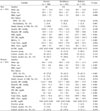4. Harris MI, Flegal KM, Cowie CC, Eberhardt MS, Goldstein DE, Little RR, Wiedmeyer HM, Byrd-Holt DD. Prevalence of diabetes, impaired fasting glucose, and impaired glucose tolerance in U.S. adults. Diabetes Care. 1996. 21:518–524.
5. Wild S, Roglic G, Green A, Sicree R, King H. Global prevalence of diabetes. Diabetes Care. 2004. 27:1047–1053.
6. Zimmet PZ. Challenges in diabetes epidemiology-from West to the rest. Diabetes Care. 1992. 15:232–252.
7. Agardh EE, Ahlbom A, Andersson T, Efendic S, Grill V, Hallqvist J, Ostenson CG. Socio-economic position at three points in life in association with type 2 diabetes and impaired glucose tolerance in middle-aged Swedish men and women. Int J Epidemiol. 2007. 36:84–92.
8. Ko GT, Chan JC, Yeung VT, Chow CC, Tsang LW, Cockram CS. A low socio-economic status is an additional risk factor for glucose intolerance in high risk Hong Kong Chinese. Eur J of Epidemiol. 2001. 17:289–295.
9. Rabi DM, Edwards AL, Southern DA, Svenson LW, Sargious PM, Norton P, Larsen ET, Ghali WA. Association of socio-economic status with diabetes prevalence and utilization of diabetes care service. BMC Health Serv Res. 2006. 6:124.
10. Robbins JM, Vaccarino V, Zhang H, Kasl SV. Socioeconomic status and type 2 diabetes in African American and Non-Hispanic white women and men: Evidence from the third national health and nutrition examination survey. Am J Public Health. 2001. 91:76–83.
11. Beckles GLA, Thompson-Reid PE. Socioeconomic status of women with diabetes-Unites States, 2000. MMWR. 2002. 51:147–159.
12. Nathan DM, Davidson MB, DeFronzo RA, Heine RJ, Henry RR, Pratley R, Zinman B. Impaired fasting glucose and impaired glucose tolerance : implications for care. Diabetes care. 2007. 30:753–759.
13. Benjamin SM, Valdez R, Geiss LS, Rolka DB, Narayan KM. Estimated number of adults with prediabetes in the US in 2000: Opportunities for prevention. Diabetes Care. 2003. 26:645–649.
14. Abdul-Ghani MA, Tripathy D, DeFronzo RA. Contributions of beta-cell dysfunction and insulin resistance to the pathogenesis of impaired glucose tolerance and impaired fasting glucose. Diabetes Care. 2006. 29:1130–1139.
15. Dunstan DW, Zimmet PZ, Welborn TA, De Courten MP, Cameron AJ, Sicree RA, Dwyer T, Colagiuri S, Jolley D, Knuiman M, Atkins R, Shaw JE. The Australian Diabetes, Obesity and Lifestyle Study. The rising prevalence of diabetes and impaired glucose tolerance. Diabetes Care. 2002. 25:829–834.
16. Tuomilehto J, Lindstrom J, Eriksson JG, Valle TT, Hamalainen H, Ilanne-Parikka P, Keinanen-Kiukaanniemi S, Laakso M, Louheranta A, Rastas M, Salminen V, Uusitupa M. Finnish Diabetes Prevention Study Group: Prevention of type 2 diabetes mellitus by changes in lifestyle among subjects with impaired glucose tolerance. N Engl J Med. 2001. 344:1343–1350.
17. Knowler WC, Barrett-Connor E, Fowler SE, Hamman RF, Lachin JM, Walker EA, Nathan DM. Diabetes Prevention Program Research Group. Reduction in the incidence of type 2 diabetes with lifestyle intervention or metformin. N Engl J Med. 2002. 346:393–403.
18. Ramachandran A, Snehalatha C, Marry S, Mukesh B, Bhaskar AD, Vijay V. Indian Diabetes Prevention Programme (IDPP). The Indian Diabetes Prevention Programme shows that lifestyle modification and metformin prevent type 2 diabetes in Asian Indian Subjects with impaired glucose tolerance (IDDP-1). Diabetolgia. 2006. 49:289–297.
19. DECODE Study Group. the European Diabetes Epidemiology Group. Glucose tolerance and cardiovascular mortality: comparison of fasting and 2-hour diagnostic criteria. Arch Intern Med. 2001. 161:397–405.
20. Coutinho M, Gerstein HC, Wang Y, Yusuf S. The relationship between glucose and incident cardiovascular events. A metaregression analysis of published data from 20 studies of 95,783 individuals followed for 12.4 years. Diabetes Care. 1999. 22:233–240.
21. Liao D, Shofer JB, Boyko EJ, McNeely M, Leonetti DL, Kahn SE, Fujimoto WY. Abnormal glucose tolerance and increased risk for cardiovascular disease in Japanese-Americans with normal fasting glucose. Diabetes Care. 2001. 24:39–44.
22. Bjornholt JV, Erikssen G, Aaser E, Sandvik L, Nitter-Hauge S, Jervell J, Erikssen J, Thaulow E. Fasting blood glucose : an underestimated risk factor for cardiovascular death. Results from a 22-year follow-up for healthy nondiabetic men. Diabetes Care. 1999. 22:45–49.





 PDF
PDF ePub
ePub Citation
Citation Print
Print






 XML Download
XML Download